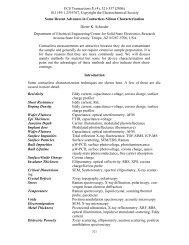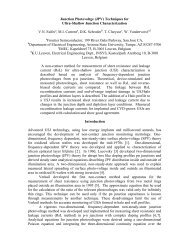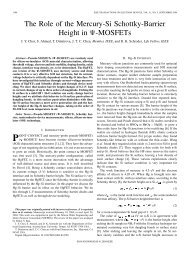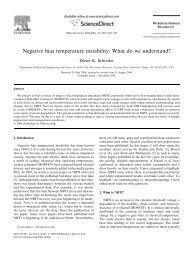Carrier Lifetimes in Silicon - Dieter Schroder - Arizona State University
Carrier Lifetimes in Silicon - Dieter Schroder - Arizona State University
Carrier Lifetimes in Silicon - Dieter Schroder - Arizona State University
Create successful ePaper yourself
Turn your PDF publications into a flip-book with our unique Google optimized e-Paper software.
SCHRODER: CARRIER LIFETIMES IN SILICON 163<br />
Fig. 6. SRH versus for N T =10 12 cm 03 ;p o =10 16 cm 03 ;E T =0:4<br />
eV; n =5210 014 cm 2 ; =1n=p o; experimental data po<strong>in</strong>ts adapted<br />
from [7].<br />
toward the band edges even at low also depends<br />
on the excess carrier density, as illustrated <strong>in</strong> Fig. 5. If<br />
and (high level <strong>in</strong>jection) then the lifetime<br />
becomes<br />
Under conditions valid for (7) or (8), for a given energy<br />
level and for given capture cross sections always <strong>in</strong>creases<br />
with <strong>in</strong>jected carrier density, as illustrated <strong>in</strong> Fig. 6. However,<br />
as shown <strong>in</strong> Fig. 5, for or<br />
the lifetime decreases with <strong>in</strong>jection level. The dependence of<br />
on is illustrated <strong>in</strong> Fig. 5 by the vertical arrows. This<br />
figure clearly shows that does not always <strong>in</strong>crease with<br />
<strong>in</strong>creas<strong>in</strong>g <strong>in</strong>jection level, as is often stated.<br />
What are typical excess carrier densities dur<strong>in</strong>g or<br />
m<strong>in</strong>ority carrier diffusion length measurements? That depends<br />
on the measurement technique. The <strong>in</strong>jection level varies<br />
dur<strong>in</strong>g photoconductance decay (PCD) measurements, as carrier<br />
density changes dur<strong>in</strong>g the measurement. It is certa<strong>in</strong>ly<br />
possible to make PCD measurements at low <strong>in</strong>jection levels.<br />
However, many PCD measurements are made under high<br />
<strong>in</strong>jection levels. Sometimes this is done to reduce surface<br />
recomb<strong>in</strong>ation, a po<strong>in</strong>t addressed later. Dur<strong>in</strong>g surface photovoltage<br />
(SPV) measurements, the open-circuit voltage is<br />
usually kept low compared to typically a few mV,<br />
to ensure a l<strong>in</strong>ear relationship between surface photovoltage<br />
and excess carrier density. The excess carrier density is<br />
is proportional to only<br />
if s<strong>in</strong>ce <strong>in</strong><br />
that case. This corresponds to<br />
i.e., the device<br />
must clearly be <strong>in</strong> low-level <strong>in</strong>jection. SPV measurements<br />
can be made under constant voltage or constant photon flux<br />
density conditions and the <strong>in</strong>jection level may change with<br />
wavelength. Clearly, the <strong>in</strong>jection level needs to be considered<br />
when compar<strong>in</strong>g lifetimes determ<strong>in</strong>ed by different techniques<br />
for the lifetimes can be very different as illustrated <strong>in</strong> Fig. 5.<br />
B. Shockley–Read–Hall Surface Recomb<strong>in</strong>ation Velocity<br />
Besides SRH bulk recomb<strong>in</strong>ation there is also SRH surface<br />
recomb<strong>in</strong>ation at bare surfaces or <strong>in</strong>terface recomb<strong>in</strong>ation<br />
(8)<br />
Fig. 7. s r versus E Ts for N it = 10 10 cm 03 ;p os = 10 16 cm 03 ;<br />
ns = 52 10 014 cm 2 ;s ps = 52 10 017 cm 2 ; the <strong>in</strong>jection level is<br />
= 1n s =p os :<br />
at <strong>in</strong>sulator/semiconductor <strong>in</strong>terfaces. Analogous to the SRH<br />
lifetime <strong>in</strong> (1), the SRH surface recomb<strong>in</strong>ation velocity is given<br />
by [5]<br />
where<br />
(9)<br />
(10)<br />
The subscript “s” refers to the appropriate quantity at the<br />
surface, with carrier densities be<strong>in</strong>g <strong>in</strong> units of cm The<br />
<strong>in</strong>terface trap density <strong>in</strong> units of cm is assumed<br />
constant <strong>in</strong> (9).<br />
The surface state density and energy distribution of a bare<br />
surface are generally only poorly known. The <strong>in</strong>terface trap<br />
density at the SiO Si <strong>in</strong>terface is quite well understood and<br />
controlled. Its energy, density, and capture cross sections vary<br />
throughout the bandgap. To treat such an <strong>in</strong>terface correctly,<br />
requires an <strong>in</strong>tegration of the recomb<strong>in</strong>ation generation rate<br />
expression. However, for a given measurement it is frequently<br />
only a small portion of the <strong>in</strong>terface trap density that is<br />
active dur<strong>in</strong>g recomb<strong>in</strong>ation or generation for any given bias.<br />
Treat<strong>in</strong>g the <strong>in</strong>terface trap density as approximately constant<br />
is a reasonable assumption. Includ<strong>in</strong>g the full version only<br />
complicates the issue and does not add to the concepts<br />
addressed here. It is worth po<strong>in</strong>t<strong>in</strong>g out that the recomb<strong>in</strong>ation<br />
statistics of the <strong>in</strong>terface traps rema<strong>in</strong> unchanged even when<br />
there is a distribution of them, s<strong>in</strong>ce the spatial distance<br />
between the traps limits the <strong>in</strong>teraction between them.<br />
The dependence of on <strong>in</strong>jection level and energy level<br />
is shown <strong>in</strong> Fig. 7. Contrary to Fig. 5 where the lifetime<br />
<strong>in</strong>creases or decreases with <strong>in</strong>jection level, the surface recomb<strong>in</strong>ation<br />
velocity exhibits the opposite behavior. Of course,<br />
both <strong>in</strong>creased lifetime and reduced surface recomb<strong>in</strong>ation<br />
velocity signify reduced recomb<strong>in</strong>ation. The dependence of<br />
on <strong>in</strong>jection level and capture cross section is shown <strong>in</strong><br />
Fig. 8. The theoretical curves <strong>in</strong> this figure were calculated<br />
with capture cross sections appropriate for <strong>in</strong>terface traps at<br />
SiO Si <strong>in</strong>terfaces [8]. The capture cross sections <strong>in</strong> Fig. 7








